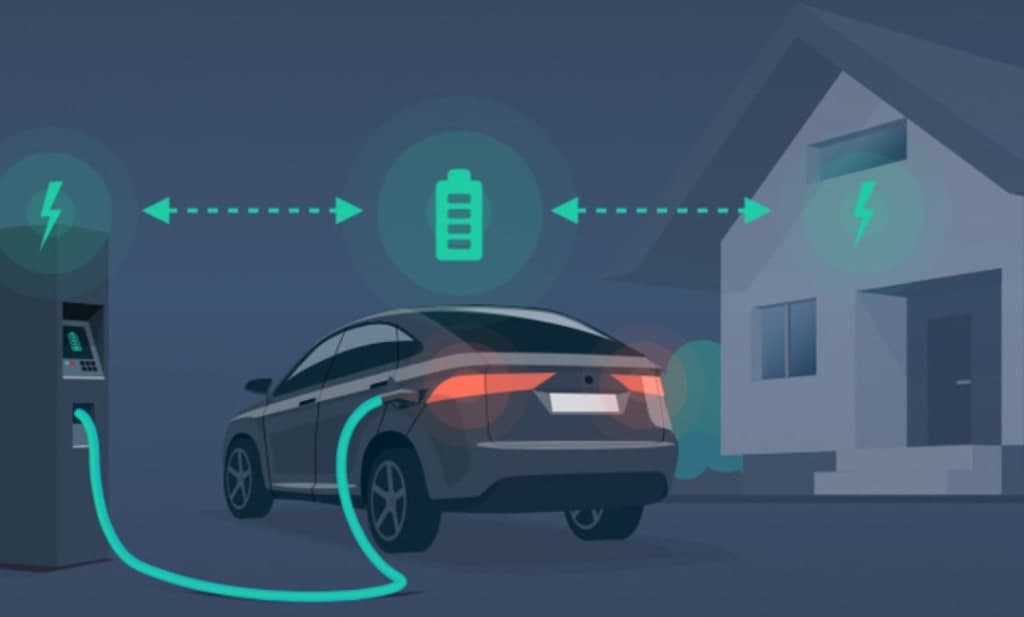
BLOG · 22/4/2023
V2G Technology
Plugging into the Future: Exploring the Power of V2G Technology

V2G stands for “vehicle to grid” and is a technology that enables energy to be pushed back to the power grid from the battery of an electric car. With electric vehicle-to-grid technology—also known as car-to-grid—a car battery can be charged and discharged based on different signals — such as energy production or consumption nearby.
\nThis technology has been gaining popularity in recent years due to its potential to reduce carbon emissions and improve grid stability.
\nThe basic principle of V2G technology involves using electric vehicles as mobile storage units for renewable energy. During times of low demand, the excess energy generated by wind turbines and solar panels can be stored in the batteries of parked electric vehicles. When demand is high, the energy stored in these batteries can be fed back into the grid.\n
\n\n## Benefits of V2G Technology\nOne of the main benefits of V2G technology is its ability to support the integration of renewable energy sources into the grid. By storing excess energy generated by renewables in electric vehicle batteries, V2G technology can help to balance fluctuations in supply and demand, which can be challenging for traditional power grids.
\nAnother benefit of V2G technology is its potential to reduce the cost of electricity for consumers. By feeding excess energy back into the grid during peak demand periods, electric vehicle owners can earn money for the energy they supply. This can offset the cost of charging their vehicles and even provide a source of income.\n \n## Challenges of V2G Technology\nDespite its potential benefits, there are several challenges associated with implementing V2G technology on a large scale. One of the biggest challenges is the need for a reliable communication network that can facilitate the exchange of information between electric vehicles and the grid. This requires significant investment in infrastructure.
\n## Challenges of V2G Technology\nDespite its potential benefits, there are several challenges associated with implementing V2G technology on a large scale. One of the biggest challenges is the need for a reliable communication network that can facilitate the exchange of information between electric vehicles and the grid. This requires significant investment in infrastructure.
\nAnother challenge is the limited availability of electric vehicles with V2G capabilities. While more and more electric vehicles are being produced with this technology, the vast majority of vehicles on the road today do not have it. This means that widespread adoption of V2G technology will require significant investment in new vehicles.\n \n\n## Real-World Applications of V2G Technology\nDespite the challenges, there are already several real-world applications of V2G technology. For example, in Denmark, a fleet of electric buses equipped with V2G technology is being used to provide balancing services to the grid. The buses charge during off-peak hours and discharge during peak hours to help stabilize the grid.\nAnother example of V2G technology in action is in the United Kingdom, where Nissan has partnered with energy company OVO to create a virtual power plant using electric vehicles. This project aims to use a fleet of Nissan LEAFs to provide balancing services to the grid and reduce the cost of electricity for consumers.\n
\n\n## Real-World Applications of V2G Technology\nDespite the challenges, there are already several real-world applications of V2G technology. For example, in Denmark, a fleet of electric buses equipped with V2G technology is being used to provide balancing services to the grid. The buses charge during off-peak hours and discharge during peak hours to help stabilize the grid.\nAnother example of V2G technology in action is in the United Kingdom, where Nissan has partnered with energy company OVO to create a virtual power plant using electric vehicles. This project aims to use a fleet of Nissan LEAFs to provide balancing services to the grid and reduce the cost of electricity for consumers.\n \n\n## Future of V2G Technology\nAs the adoption of electric vehicles continues to grow, so too does the potential for V2G technology. Experts predict that by 2030, there could be up to 30 million electric vehicles on the road worldwide, providing a massive source of energy storage and generation capacity.
\n\n## Future of V2G Technology\nAs the adoption of electric vehicles continues to grow, so too does the potential for V2G technology. Experts predict that by 2030, there could be up to 30 million electric vehicles on the road worldwide, providing a massive source of energy storage and generation capacity.
\nIn the future, V2G technology could also be used to support the growth of smart cities. By integrating electric vehicles into the wider energy ecosystem, cities could become more efficient and sustainable, reducing carbon emissions and improving quality of life for residents.
\n\n## Conclusion\nV2G technology has the potential to revolutionize the way we generate, store, and use energy. By using electric vehicles as mobile storage units for renewable energy, we can reduce our reliance on fossil fuels and improve the stability of the grid. While there are still challenges to overcome, the real-world applications of V2G technology demonstrate that it is a viable solution for a more sustainable future.
\nAs we continue to invest in renewable energy and electric vehicle infrastructure, we must also prioritize the development and implementation of V2G technology. With the right investments and policies, we can unlock the full potential of this technology and create a more sustainable and prosperous future for all.\n